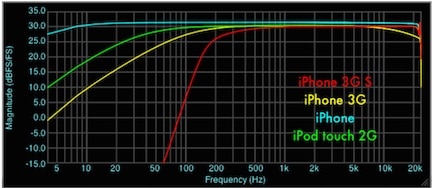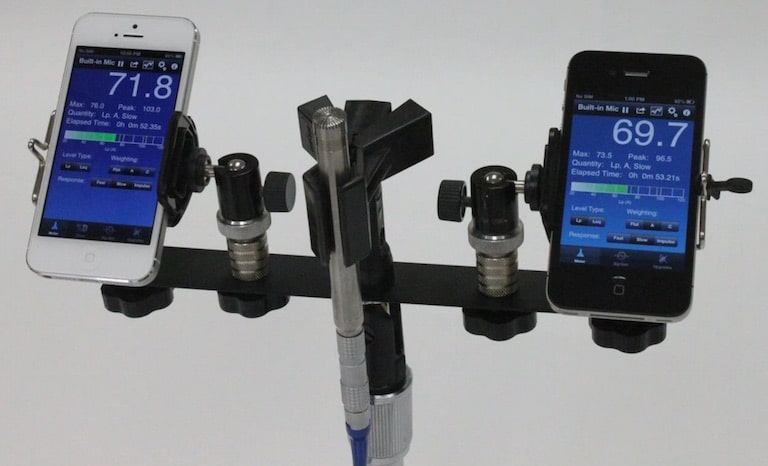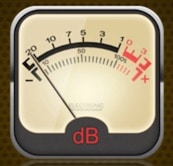Relevancy of Smartphone Sound Level Meter Apps for Occupational Purposes
Of the millions of applications (apps) available for smartphones, many developers offer a number of sound measurement apps, including some intended to function as sound level meters (SLMs) in which the smartphone’s built-in microphone is used to pick up the sound for measurement. In some more sophisticated smartphones, an external microphone can be used. This is a continuation of last week’s post and addresses some of the issues as to how well these smartphone SLM apps lend themselves to occupational noise uses.

Relevant Studies
As can be determined from the studies summarized that follow, current smartphone app combinations can measure mid-level, steady, broadband noise sources with acceptable accuracy to meet that single aspect of international standards (Robinson and Tingay, 2014){{1}}[[1]]Robinson, D. Tingay, J. Comparative study of the performance of smartphone-based sound level meter apps, with and without the application of a ½” IEC-61094-4 working standard microphone, to IEC-61672 standard metering equipment in the detection of various problematic workplace noise environments, Inter.noise 2014, Melbourne, Australia, November 16-19[[1]]. Robinson and Tingay go on to say that “laboratory-based testing performed so far do not represent the methods in which a smartphone will actually be used when taken into real-world environments, especially industrial, higher-noise-level environments where workplace noise is likely to be problematic.” They go on to say that the use of smartphone apps in genuine noise-problematic situations is fraught with inaccuracy, and that well-trained ears would be better indicators than some of the hardware/software combinations.
Kardous and Shaw (2014)
![Figure 1. Mean and standard Error of 10 iOS SLM app un-weighted and A-weighted sound levels. Best agreement from the actual reference values for each is in blue, and those within ± 2dBA, are shown in orange (± 2dBA chosen because OSHA noise standard [29 CFR 1910.95] considers type 2 instruments to have an accuracy of ± 2dBA). The agreement with the reference sound level measurements shows that the apps in colored boxes may be considered adequate (over the range tested) for certain occupational noise assessments.](https://hearinghealthmatters.org/wp-content/uploads/2015/07/iOS-SLM-App-Comparisons.jpg)
Figure 1. Mean and standard Error of 10 iOS SLM app un-weighted and A-weighted sound levels. Best agreement from the actual reference values for each is in blue, and those within ± 2dBA, are shown in orange (± 2dBA chosen because OSHA noise standard [29 CFR 1910.95] considers type 2 instruments to have an accuracy of ± 2dBA). The agreement with the reference sound level measurements shows that the apps in colored boxes may be considered adequate (over the range tested) for certain occupational noise assessments.
Several apps and devices were within ± 2dBA as considered for a type 2 SLM (Kardous and Shaw, 2014){{2}}[[2]]Kardous, C. A., & Shaw, P. B. (2014). Evaluation of smartphone sound measurement applications. The Journal of the Acoustical Society of America, 135(4), EL186-EL192[[2]], as shown in Figure 1. They suggested that a handful of such smartphone SLM apps, when installed on certain devices and used to measure steady pink noise in a controlled test environment, are accurate enough to meet international standards for metering equipment. These could serve to empower workers and help them make educated decisions about their work environments. These apps may be useful for industrial hygienists and OS&H managers to make quick spot measurements to determine if noise levels exist in a workplace that can harm workers’ hearing. CDC – NIOSH Science Blog – So How Accurate Are These Smartphone Sound Measurement Apps? .
Nast, Speer and LePrell (2014)
These researchers reported results similar to those of Kardous and Shaw. Five iPhone applications with default settings were loaded onto a new iPhone 4S. The devices were exposed to narrow band 250-8000 Hz noise. They go on to say that unless the accuracy of an app has been determined, consumers should be hesitant to trust noise level estimates based solely on the app-based measurements{{3}}[[3]]Nast, D.R., Speer, W.S., LePrell,C.G. Sound level measurements using smartphone “apps”: Useful or inaccurate? Noise Health [serial online] 2014 [cited 2015 Jun 30]:16:251-6. Available from: http://www.noiseandhealth.org/text.asp?2014/16/72/251/140495[[3]].
Keene et. al. (2013)
Using a pink noise source and the QuickSIN3 test at 85 and 95 dB HL, these researchers determined that it was evident from their studies that many smartphone SLM apps could make rather accurate measurements within the constraints of the test{{4}}[[4]]Keene, K., et. al. (2013), Accuracy of smartphone sound level meter applications, Canadian Hearing Report, Vol. 8, No 6, Canadian Academy of Audiology, Andrew John Publishing Inc. ON, Canada[[4]]. They examined the accuracy of three different free SLM apps on iPhone® and Android® smartphones, comparing the results against a gold standard, type 1 SLM. Results indicated that the Android apps were inaccurate at determining noise levels and under-reported the true level of the noise. The iPhone apps performed well at the low intensity level, but at 95 dB HL, measurements on all the apps were inaccurate because the values saturated after a maximum level. Therefore, while sound level meter applications may be used on smartphones such as iPhones and Androids to help evaluate the noise conditions of an environment, they may have limitations in their accuracy. Audiologists are advised to validate sound level meter applications against an independent source across input levels prior to use.
Robinson and Tingay (2014)
It might be thought that an increasing prevalence of sound level meter apps appearing may be a concern to manufacturers of metering equipment, but such systems are readily disregarded by professionals due to unacceptable inaccuracy, incorrect measurement methods or parameters. While it may be argued that approximate readings, provided by smartphone metering, can at least offer an indication that further investigation may be necessary, there exists the real chance that the shortfalls in equipment properly measuring the full range of required acoustical parameters will lead to non-detection of significant workplace or environmental noise problems (Robinson and Tingay, 2014). Additionally, the controlled test environments used in previous research are arguably not representative of the actual manner in which a smartphone is used as a SLM for real-world measurements. Consequentially, there are of course a vast number of other acoustical tests that form the complete ANSI S1.4 and IEC-61672 standards, addressing the directional response of the SLM, distortion, linearity, tone-burst response etc. Although not made explicitly within any found study, the suggestion that a device is meeting the ANSI standard by conforming to only one aspect of the specifications is misleading.
They summarize their investigations into smartphone SLM apps, stating that if a SLM app is designed for one specific model and variant smartphone, a noise monitoring device could be produced. However, with the unrestricted variation in hardware between manufacturers, their models and even period/factory of manufacture, it is dubious that an app can be applicable to a wide range of devices.
Ostendorf (2011, 2012, 2013)
As reported by Robinson and Tingay, Ostendorf’s investigations tested further than previous studies, and applied different noise sources. In contrast to positive outcomes of aforementioned steady-noise testing, he found the SLM apps deviated drastically from that measured by a class 1 meter. Using the same iPhone, different apps were used to measure various steady noise and single frequency tones. He found differences of >38 dB between apps for as steady 80 Hz sinusoid.
Woolworth (2014)
He reports differences of 10 dB when performing field tests, both indoors and outdoors{{5}}[[5]] Woolworth, D. (2014), Institute of Acoustics LinkedIn discussion group post, https://www.linkedin.com/groupItem?view=andgid=678647andtype=memberanditem=587846724471 9116291andcommentID=5890216976327925760andtrk=groups_search_item_list-0-b-cmnandgoback= .gmp_678647.gna_678647#commentID_5890216976327925760[[5]].
Issues Affecting Accuracy
- Microphones
A major limitation of smartphone SLM apps is related to the microphones. Because most smartphone function relates to the transmission of human voice, this can be conveyed within a bandwidth much smaller than the human auditory range (20 to 20,000 Hz). Because of this, mobile device mics have not required flat, wide frequency spectrum response as is required of measurement microphones. It would not have been uncommon to find polymer membrane electret condenser types, with a resonance of only a few kilohertz.
The introduction of MEMS (Micro-Electro-Mechanical-System) mics have changed much of this because they have flat responses (similar to a 1/2” electret or externally-polarized condenser microphones). MEMS mics do suffer because they have an unfavorable noise floor – struggling to achieve much over 60 dB SNR (Robinson and Tingay, 2014). A limit exists also at the upper end with 120 dBA being a general maximum. Also, preliminary results by Kardous and Shaw (2014) showed greater accuracy when the SLM app allowed for use of an external microphone.
MEMS are commonly installed within the casings of smartphones, and directly soldered to the circuit board. This adds to the robustness, but also introduces an acoustical filtering network, which can amplify or attenuate certain frequencies (Robinson and Tingay, 2014).
- Smartphones Designed for High Quality, Rather Than for a Flat Response
A high-pass filter is often designed into the smartphone to reduce “pop” or wind noise. In iOS v. 6 onward, it is possible to turn off the filter within software, but it is not known if a particular app does this or not.
- Digital Signal Processing (DSP)

Figure 2. Input frequency response of various iPhone models, indicating high-pass filtering{{6}}[[6]]Fabor, B. (2009). iPhone dock and headset IO frequency response[[6]].
DSP algorithms are widely implemented within the regular audio channel to reduce the signal bandwidth and bit rate. The theory is that removal of certain portions of the audio signal that would not normally be perceived, eliminates redundancy. While this may be true for speech, it is not valid to do so regarding exposure, where the total energy is not based on perceptual, but on the total energy reaching the auditory system (Figure 2).
- Impulse Noise
Impulse noise assessment is a tricky issue by itself because even type 1 SLMs are often not capable of measuring impulses that exceed the dynamic range of the meter.
- General
Variability can be expected in smartphone SLM apps due to the variation in hardware between manufacturers, the differences in their models, period and factory of manufacture, design of the devices, and the variety of manners in which measurements can be taken. The following list of issues that can result in variability is not exhaustive, but offers some issues to look at when attempting to compare smartphone SLMs (adapted from Robinson and Tingay (2104).
- Device calibration. Non-calibrated smartphone meter apps lead to very high inaccuracies in the majority of cases,
- Hardware varies significantly, with no knowledge of the application designer in the absolute sensitivity of the microphone nor its response,
- Microphones are placed in a location on the device which may not be suited for accurate acoustical measurement,
- Hardware capabilities may be lacking in the ability to properly capture noise levels without refraction or reflection,
- Other software may be running on the device; apparent or not; with the possibility of interrupting background tasks,
- Performance may be compromised by the current state of the operating system; availability of free memory or storage,
- Filtering may or may not be applied to the microphone; it is often found that a high pass anti -pop filter is applied, which would be a detriment to low-frequency measurements,
- By design, mobile devices rarely have physical protection against wind noise. Without any protection, measurements in anything other than still air environments would be unacceptably inaccurate.
Suggested Measurement Method
For accurate measurements and comparisons, a method used by Kardous and Shaw (2014) serves as a good example (Figure 3). Additional considerations mentioned in this post can be added to improve upon this protocol, leading to improved results. The calibrated microphone in the center serves as the reference sound level.

Figure 3. A suggested procedure for measuring and comparing smart phone sound level meter (SLM) apps. The SoundMeter app on the iPhone 5 (left) and iPhone 4S (right) compared to ½” Larson-Davis 2559 random incidence type 1 microphone (center). From Kardous and Shaw, 2014). The smartphones were attached to a stand in the middle of the reverberant sound chamber at a height of 4 feet, and about 6 inches from the reference microphone.








The body of all of audiology practice work is based on noise and sounds. The goal is to bring the most dynamic sound portfolio possible, to those who cannot experience it naturally. To understand how to amplify noise and sound, we need to understand how it works.